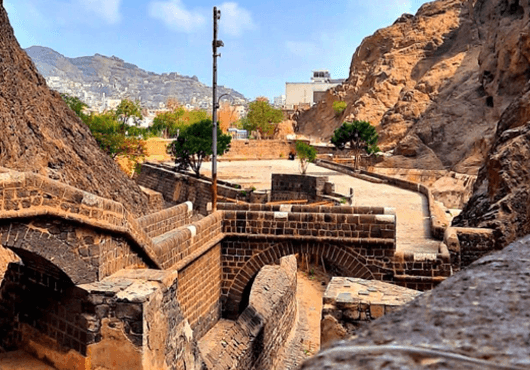Portland Pozzolana Cement
- Portland Pozzolana cement is featured by having different specifications and ingredients from other types of Portland cements.
- It is composed of (70% -80%) of Portland cement, added to that a ratio of (15-20%) of Pozzolana. ( Pozzolana is a naturally siliceous, aluminous and volcanic material extracted directly from volcanic mountains.
- It is produced by adding Pozzolana to the ordinary Portland cement clinker.
- Types and sources of pozzalana:
- Natural renewable pozlana resulting from ash and lava.
- Industrial pozlana resulting from recycling factory waste.
- Coal ash from burning coal for power plants.
- Iron slag resulting from the residues of burning iron in the furnace of iron and steel factories.

pozzolanic cement
Types of pozzolanic cement
- PULVERISED FUEL ASH AFA consists of mixing ordinary pozzolanic cement with OPC with 20-30% of coal ash.
- GGBFS It consists of mixing ordinary Portland cement (OPC) with 70% iron slag.
- POZZLANA CEMENT PPC PORTLAND consists of mixing OPC ordinary Portland cement with 20-30% of natural pozzolana.
pozzolanic cement
Characteristics and Properties of NCC Portland Pozzolana Cement
- Portland Pozzolana cement plays a very important role in making cement paste PPC plays a role in making cement paste, plastic and malleable (for doing internal and external finishes.
- PPC reduces the heat generated from the first phase of water is added.
- It reduces cement permeability in plain and enforced concrete.
- It improves the plastic and bonding feature of cement grout (to be suitable for plastering).
- It acts as a heat insulator (it reduces electric power consumption used for lighting and air conditioning).
- It has the property of absorbing any noise and helps in reducing sound echoing, that is, it has an excellent acoustic property.
- It increases fire resistance (due to that Pozzolana has silica and alumina, this type of cement tolerates high temperatures during fires; thus, we see that furnace chimneys are made of PPC.)
- It has a high resistance sulfates, chlorides and acids.
- It has a high resistance to interaction of alkalis with silicate.
- It reduces porosity and permeability and increases the surface of the granules.
- It reduces cement permeability in plain and enforced concrete.
- It has high sulfate resistance (All construction works and buildings done along coastal areas or on on soil rich with dissolved sulfate).
- It has an overtime resistance to weathering conditions (Actually, archaeological monuments and historical sites are built of rocks of a volcanic origin. A living testimony is the presence of old Roman palaces).
- It reduces the high temperature generated by high C3S content.
Cement Buzolana in European specifications
| Cement Grade | CEMENT TYPE | COMPOSITION |
|---|---|---|
| CEM I | ORDANERY PORTLAND CEMENT | 100% CLINKER +/_5% ADDITIVES |
| CEM II | PORTLAND POZOLANIC CEMEN | 85-65% CLINKER + 15-35% POZZOLNA |
| CEM V | POZOLANIC CEMENT | 65-45% CLINKER + 36-55% POZOLANA |
Benefits and Advantages of Pozzolanic Portland Cement Uses
At the Level of company Cement Plant:
- The productivity of the plant increases because the temperature drops down.
- The amount of energy, heat and electric consumption would be reduced.
- Carbon dioxide emission would decrease.
- The cost of concrete production is reduced because of adding Pozzolana.
- Disease rates among staff and workers of NCC plant would drop down.
- Environmental pollution is limited and reduced in the plant's site and NCC surrounding areas.
At the level of the Concrete Quality
- The concrete made of Portland Pozzolana cement would be easily compacted, more ductile, smoother and better handled and dealt with when cast and poured.
- PPC concrete would be easier to pump to the site.
- Water used at the time of making of any concrete mixes would be reduced.
- A smooth surface of the concrete would be obtained after casting it.
- This type of concrete would save effort, time and manpower to produce it.
- Concrete resistance to alkali reaction would be enhanced.
- Concrete bonding would be stronger.
- Concrete resistance to sulfates and acids is augmented.
- PPC Concrete resistance to any thermal activities is increased.
At the Level of Environment :
- Since adding Pozzolana material reduces. Carbon dioxide emission in ordinary cement production, then this would reduce global warming.
- The impacts and damage done to human health would decrease due to the emission of gases from ordinary cement manufacturing.
- There would be a cleaner environment by recycling industrial by-products resulting from power stations and metal factories operations.
At the Level of Buildings and Structures
- The life time of buildings / structures is raised by the increase in the life time of the building materials.
- The consumption of the amount of energy would be reduced.
- Thermal insulation would be decreased.
- Corrosion of iron used in reinforced concrete would be limited and lowered.
- Thermal cracking would be prevented.
- The building's resistance to sulfate and acid is stronger.
- Water consumption would drop down.
- Effort, time and manpower would be reduced.
At the level of the National Economy :
- Large amounts of water used in the making of concretes, blocks and construction of buildings would be saved and thus used in producing ordinary cements.
- Clinker raw materials used to make ordinary cement would be saved for future generations. Costs of ordinary cement production would be reduced.
- Diseases caused by ordinary cement manufacturing would decrease.
- Environmental pollution is limited and reduced.
- Reducing the percentage of global warming as result of cement manufacturing is another advantage.


